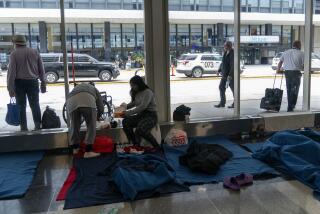U.S. Demands On-Time Flights at Busiest Airport
- Share via
WASHINGTON — Transportation Secretary Norman Y. Mineta issued an ultimatum to the nation’s major airlines Wednesday, telling them to get flights running on time at the nation’s busiest airport or his agency would intervene.
Delays at O’Hare International Airport in Chicago are “choking travel across the heartland of America and causing massive backups that ripple across our aviation system,” Mineta told a group of airline representatives called to Washington for unprecedented negotiations aimed at relieving congestion at the airport.
After hours behind closed doors, the first day of talks ended without resolution.
The talks were to continue today.
Mineta said the Federal Aviation Administration was prepared to cut the number of flights going in and out of O’Hare if the airlines did not make voluntary reductions. The agency is not considering cuts at any other airports, FAA spokesman William Shumann said.
The meeting in Washington was the first of its kind, Shumann said. As part of the FAA reauthorization bill passed last fall, Congress gave the Transportation secretary the power to bring airlines to the table to prevent overscheduling.
The FAA’s threat comes as the number of Americans flying is reaching pre-Sept. 11 levels, and as delays at O’Hare are reaching historic numbers.
The FAA considers a flight delayed when it varies 15 minutes or more from its schedule.
Since January, 58,600 flights into and out of O’Hare have been late -- more than the yearly totals for 2000, 2001 and 2002, Mineta said.
Air industry experts blamed the airport’s increased air traffic and out-of-date infrastructure for the delays. Last year, about 928,000 flights, carrying 69.5 million passengers, went through O’Hare.
The bottleneck in Chicago has left travelers waiting in airports across the country. In May, for example, 40% of all United Airlines flights leaving O’Hare for LAX were delayed. The average wait was 40 minutes, the Transportation Department’s Bureau of Transportation Statistics said.
The FAA has forced United, which uses O’Hare as its main hub, and American Airlines to take steps toward easing congestion at the airport.
The two airlines reduced flights by 5% in March and an additional 2.5% in June. The airlines have adjusted their schedules to minimize crowding at gates during peak hours.
“Chicago O’Hare’s on-time performance is unacceptable, even with peak-hour schedule reductions by the two largest airlines serving that airport,” Mineta said.
Spokesmen for United and American said that if additional schedule changes were necessary, other carriers should share the burden.
“We’ve already stepped up to the plate and made a number of different sacrifices and cutbacks and concessions,” said Stephan Roth of United.
Roth said the long-term solution was a $15-billion modernization plan that would revamp the runways so they could be used more efficiently.
“But for now, we’d expect any of these short-term proposals to be equitable among all the airlines,” Roth said.
As a starting point for negotiations, FAA Administrator Marion C. Blakey said airlines should limit flights to 22 arrivals every 15 minutes.
Officials at United and American contended that the airport could handle more flights, as did Chicago’s aviation commissioner, John A. Roberson.
Currently, 78 to 101 planes an hour land at O’Hare during the day. By comparison, LAX averages around 70, the FAA said.
Roberson said FAA officials were open to some “flexibility and latitude.”
More to Read
Inside the business of entertainment
The Wide Shot brings you news, analysis and insights on everything from streaming wars to production — and what it all means for the future.
You may occasionally receive promotional content from the Los Angeles Times.











